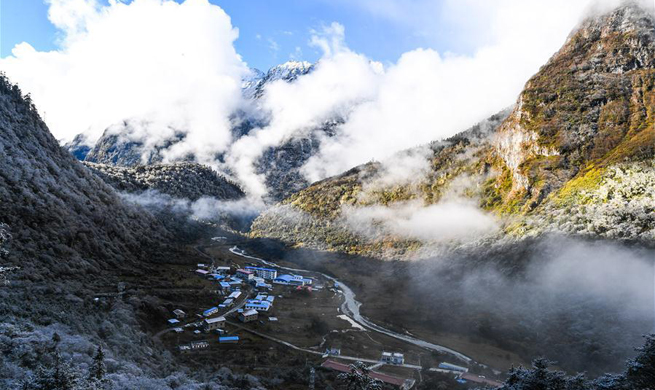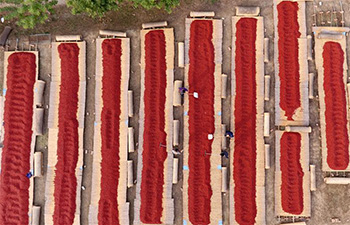KAABONG, Uganda Nov. 2 (Xinhua) -- Battered by the harsh climate change effects coupled with animal-human conflicts, locals in the semi-arid northeastern Uganda have resorted to commercial tree farming as a new livelihood.
Previously pastoralists, turned crop farmers, many villagers here are turning to tree farming to beat the harsh climate change effects and conflict with animals.
The locals' farm land borders the Kidepo National Park. Because of this, elephants, warthogs and other animals easily cross to their gardens, leaving everything destroyed.
"On numerous occasions I have planted crops like sorghum, sun flower and maize on commercial scale on this land. But you wake up one morning to find the wild animals have eaten up and destroyed crops on a huge stretch of the garden," Doreen Imen told Xinhua in an interview recently.
SOLUTION
As a way of co-existence with the wild, the UN Food and Agriculture Organization (FAO) is helping the villagers plant trees.
On her 16.5 hectares of land, Imen is establishing a commercial tree plantation comprising of Melia voklensi and Grevillea Robusta tree species. The 16.5 hectares will take up 45,551 tree seedlings.
"Warthogs and elephants are the deadliest. A single herd of elephants could destroy a huge stretch of crops. The trees I'm planting are not palatable to the wildlife. But they are a reliable long-term investment. I have already prepared the land for the trees," Imen said.
Through a 15 million U.S. dollars initiative, FAO, the European Union and the Uganda government are spearheading a countrywide campaign to promote commercial tree planting.
The initiative is aimed at mitigating the impact of climatic change as well as enhancing the earnings of households through trade in timber.
The scheme provides both quality tree seedlings and advisory services to beneficiaries.
To qualify for the grant as a commercial tree planter, a beneficiary must possess a minimum of 15 hectares of land dedicated to the establishment of a forest plantation. The maximum area that can be funded by the scheme is 3,000 hectares.
Elsewhere in Uganda the scheme has helped establish over 50,000 hectares of plantations for timber, poles and fuel wood since its inception in 2004.
In this part of the country also known as Karamoja sub region, it is the first time it is being established.
"Given the fact that this area is semi-arid and the rate at which the forests are cleared for various purposes is high, we felt this was worrying. We focused our attention here and sent out the second round of invitation for applicants in May. A total of 50 applications were received out of which 36 qualified," Leonidas Hitimana, the FAO project coordinator told Xinhua.
Hitimana said the target for Karamoja is to reach 1,000 hectares by 2020.
FAO is supplying the farmers with drought-tolerant tree species to mitigate the risk of erratic weather conditions in the area.
Andrew Napaja, the Moroto district chairperson said that getting residents within Karamoja sub region into the habit of planting trees will require concerted effort from all fronts.
"Not many people know the benefits of planting trees. Here, trees grow freely in the wild. Anybody who needs a tree just goes and picks at no cost. Technical people need to come out regularly and explain to the people the dangers of cutting trees and benefits of planting them. We are facing frequent annual food shortages here. We need trees more than any part of this country," Napaja said.

















